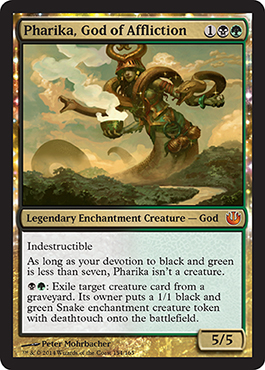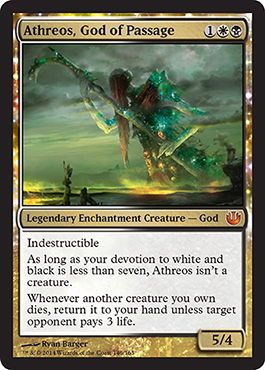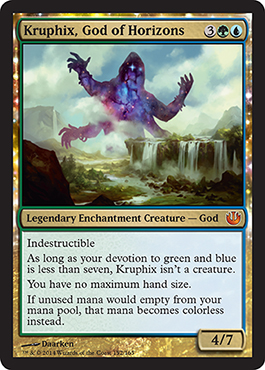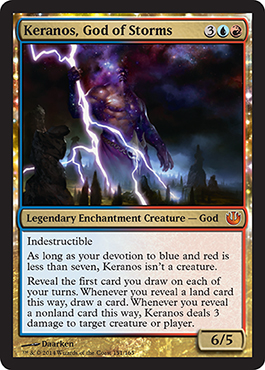UL's back with the Journey Into Nyx Set Review with the Legendary Creatures of the set. Though we only had 6, there's plenty to talk about.
So let's kick it off in spoiler reverse.
I'm not sure what the deal is with Pharika. It's clear to me that this card was designed bottoms up because this is not the flavor that has been outlined in the cards and surrounding literature concerning Theros and the Gods.
To be fair, I'm not sure what the flavor would look like for a Creature that's supposed to be both creator and healer for all the maladies of the plane, but this is not it, and Golgari players everywhere are now suffering. Snakes, +1/+1 counters, or Jarad Buffs are too many choices, and though none of them are really better than the others, they aren't collectively good either.
Aside from being an aggressively-costed God, Pharika is terrible from about every perspective I can measure, and that's disappointing. I feel that in every set, Wizards takes one card in their cycle, and just tanks it on purpose. This is it.
I'm very put off by the artwork. With such an elegant card border, many of the Theros block Gods seem to be heightened by the re-framing.
However, our friend Athreos is clearly not, and the contrast is serious. In fact, I think it's just the whole color palette. I'm not sure what Ryan Barger thought or what he was instructed to do with the artwork, but I'm really feeling like I need to call into question what he thought "God of Passage" meant. The acrid yellow smoke off the water (DRNT-DRNT-DRRR, DRNT-DRNT-DURR-NURR) doesn't conjure up the idea that Athreos is a Charon allusion ferrying Theronians (Theronites?) across a comparable version of the river Styx, but really? A blindfolded piece of Nuclear-Flubber-turned-Grim-Reaper as he drags them through the remnants of what a toilet looks like after high school kids come back from their first night of drinking.
That sounds critical, but I'm not upset about the mechanical design of Athreos. I'm okay with it. However, I would've welcomed the inclusion of a boat. I just don't know how he plans on transporting anyone. I don't know anyone, living or dead, who'd happily grab on to his gross body, sit on top of a god's scythe when traversing to the afterlife.
So we're moving from tangible and disgusting to the unseen and amorphous.
I'll admit I had the worst time trying to figure out if R&D made a mistake with Kruphix's 4th ability, consulting both GG and my playgroup's rules guru/almost Magic Judge.
It felt like an unemptying mana pool was implied, but not stated. On almost every card of its kind, Wizards has done a real "beat-me-over-the-head" job of explaining via reminder text that the mana doesn't empty from the mana pool as steps and phases end, like Omnath.
However, this is not Omnath at all. By being a replacement effect, Wizards has done a clever thing to make the design slightly more elegant while maintaining functionality. And, as I pointed out to GG, the lack of explanation adds to Kruphix's mystery. So at the very least, the designers are scoring points for flavor victories.
I didn't pick the order, but we've got back-to-back hits. Because I'm a huge fan of Keranos.
Though it is probably because of GG, I'm obligated to give two looks to any Magic card that says, "Draw a card." It's the three little words R&D could put on basically anything and I'd at least say, "Well... I'll try it."
Keranos, however, is a little more than that. Unlike Mogis's opt-sac/pitiful 2 damage, Theros' resident bolt-thrower is going to generate value for you no matter what's on the top of your library, which is also something that's within your control in these colors.
There are a lot of selling points for playing Keranos in Commander. He works well with Izzet's most recent additions (Niv-Mizzet Dracogenius and Melek), and he plays well with the bulky damage doubling enchantments that Red wants to play. You might even be able to play Creature-less with a nice control package.
This is a deck I hope to see around, mostly because I want to blast this whenever someone casts him.
And speaking of decks that will probably be rampant, we should all be giving a big kitchen table welcome to Iroas. Designed with such savory, intentional goodness, the new Red-White God of Victory seems to have been born with a gigantic ego and big-game abilities to match.
The first question I have to ask on Iroas is, "Where da Nyx?"
An overwhelming majority of the God artwork seems to carry that special midnight-sparkle, and I don't get how Iroas and Pharika didn't get there. Maybe there just wasn't enough left after Kruphix used it to support that ambiguous appetite. I'm not saying it isn't cool for Wizards to go against their own flavor. I think it would add more to this picture, rather than just having a faded centaur along the skyline.
This is by far the most aggressive of the Gods since Thassa, and it's going to show up in Standard. As such, I think it'll show up at Commander tables a little later, but Iroas is ready to go right now. Having both Pyreheart Wolf and Dolmen Gate is a huge bonus, and there's plenty of incentive to getting the 7/4 online and attacking.
Although I have been looking for a viable Red/White EDH deck, I'm a little off-put by this one. The obviously good card will always be obvious, and it just feels a little too easy to build. That doesn't mean I don't think it'll be good- I would have just preferred a little bit of a challenge.
Our last card is the only non-God Legend in the block, and the oddest.
Meet MTG's King Midas. Because everyone he touches turns to Gold tokens, which you can sacrifice to add one mana of any color to your mana pool.
Back at BotG spoilers, I thought we might get something like this based on Gild, the which does what this cursed King does when he's "Inspired." This block has been full of foreshadowing.
Whereas I find Iroas good, but easy to build, I find Macar bad, but challenging. That's intriguing to me. Combined with a great piece of art by Greg Staples and we've got ourselves a stew going. I really hope to see someone overcome the weirdness of his ability, and his lone Creature type. There's a deck here, for sure.
Well, that kicks off spoiler week. Be sure to check out GG's Review of the Set, splitting it into Threats/Answers/Mana as we've switch to full Journey into Nyx mode here on TGZ.
Pass Turn.
-UL




